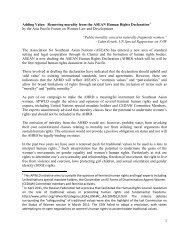A Digest of Case Law on the Human Rights of Women - Asia Pacific ...
A Digest of Case Law on the Human Rights of Women - Asia Pacific ...
A Digest of Case Law on the Human Rights of Women - Asia Pacific ...
You also want an ePaper? Increase the reach of your titles
YUMPU automatically turns print PDFs into web optimized ePapers that Google loves.
CEDAW Country Ratificati<strong>on</strong> Report: Republic <str<strong>on</strong>g>of</str<strong>on</strong>g> Korea<br />
Article 11 <str<strong>on</strong>g>of</str<strong>on</strong>g> CEDAW, which provides for <strong>the</strong> aboliti<strong>on</strong> <str<strong>on</strong>g>of</str<strong>on</strong>g> discriminati<strong>on</strong> against<br />
women in employment, was incorporated into <strong>the</strong> C<strong>on</strong>stituti<strong>on</strong> by <strong>the</strong> 1987<br />
amendments to Article 32(4). It extended protecti<strong>on</strong> to women’s labour and prohibited<br />
unjustifiable unequal treatment <str<strong>on</strong>g>of</str<strong>on</strong>g> women in employment, wage and labour c<strong>on</strong>diti<strong>on</strong>s.<br />
Fur<strong>the</strong>r, <strong>the</strong> enactment <str<strong>on</strong>g>of</str<strong>on</strong>g> <strong>the</strong> Gender Equal Employment <str<strong>on</strong>g>Law</str<strong>on</strong>g> 1987 now provides<br />
maternity protecti<strong>on</strong> and gender neutral equality <str<strong>on</strong>g>of</str<strong>on</strong>g> female labourers. It defines<br />
gender equality throughout <strong>the</strong> general aspect <str<strong>on</strong>g>of</str<strong>on</strong>g> employment. The first amendments<br />
to this law in 1989 under Article 6(2) also introduced <strong>the</strong> c<strong>on</strong>cept <str<strong>on</strong>g>of</str<strong>on</strong>g> equal pay<br />
for equal wages. This was extended in 1995 to <strong>the</strong> recruitment process prohibiting<br />
c<strong>on</strong>siderati<strong>on</strong>s based <strong>on</strong> physical requirements and a woman’s unmarried status. In<br />
additi<strong>on</strong> Article 7 was later inserted to prohibit <strong>the</strong> unfair treatment <str<strong>on</strong>g>of</str<strong>on</strong>g> women <strong>on</strong><br />
<strong>the</strong> basis <str<strong>on</strong>g>of</str<strong>on</strong>g> marriage, pregnancy, birth or sex. Article 11 <str<strong>on</strong>g>of</str<strong>on</strong>g> CEDAW has also been<br />
incorporated into Korean domestic law by <strong>the</strong> enactment <str<strong>on</strong>g>of</str<strong>on</strong>g> <strong>the</strong> Infant Nurturing <str<strong>on</strong>g>Law</str<strong>on</strong>g><br />
1991.<br />
Article 16 <str<strong>on</strong>g>of</str<strong>on</strong>g> CEDAW was incorporated into <strong>the</strong> 1990 amendments to <strong>the</strong> Civil <str<strong>on</strong>g>Law</str<strong>on</strong>g><br />
which provides for gender equality in <strong>the</strong> areas <str<strong>on</strong>g>of</str<strong>on</strong>g> property divisi<strong>on</strong>, inheritance,<br />
child custody, and <strong>the</strong> rights <str<strong>on</strong>g>of</str<strong>on</strong>g> divorced parents.<br />
A number <str<strong>on</strong>g>of</str<strong>on</strong>g> Korean cases have referred to <strong>the</strong> domestic legislati<strong>on</strong> that has been<br />
amended to accord with <strong>the</strong> provisi<strong>on</strong>s <str<strong>on</strong>g>of</str<strong>on</strong>g> CEDAW. However, despite <strong>the</strong> changes to<br />
domestic law <strong>the</strong> courts have <str<strong>on</strong>g>of</str<strong>on</strong>g>ten not interpreted <strong>the</strong>ir provisi<strong>on</strong>s to <strong>the</strong> benefit <str<strong>on</strong>g>of</str<strong>on</strong>g><br />
women. For example, <strong>the</strong> courts have found that <strong>the</strong> criminal law <str<strong>on</strong>g>of</str<strong>on</strong>g> adultery does<br />
not violate <strong>the</strong> C<strong>on</strong>stituti<strong>on</strong>. In that case <strong>the</strong> Court held that <strong>the</strong> law was essential to<br />
maintain <strong>the</strong> matrim<strong>on</strong>ial system <str<strong>on</strong>g>of</str<strong>on</strong>g> <strong>on</strong>e-husband and <strong>on</strong>e-wife, to guarantee family<br />
life and <strong>the</strong> protecti<strong>on</strong> <str<strong>on</strong>g>of</str<strong>on</strong>g> sexual obligati<strong>on</strong>s for sincerity between spouses, and to<br />
prevent social harms caused by adultery. Fur<strong>the</strong>r, <strong>the</strong> Court held that <strong>the</strong> crime <str<strong>on</strong>g>of</str<strong>on</strong>g><br />
adultery does not interfere with <strong>the</strong> true nature <str<strong>on</strong>g>of</str<strong>on</strong>g> freedom and rights or <strong>the</strong> equality<br />
provisi<strong>on</strong>s <str<strong>on</strong>g>of</str<strong>on</strong>g> <strong>the</strong> C<strong>on</strong>stituti<strong>on</strong>. The dissenting opini<strong>on</strong>, however, held that <strong>the</strong> crime<br />
<str<strong>on</strong>g>of</str<strong>on</strong>g> adultery was in breach <str<strong>on</strong>g>of</str<strong>on</strong>g> <strong>the</strong> C<strong>on</strong>stituti<strong>on</strong>.<br />
The courts have also interpreted <strong>the</strong> Gender Equal Employment <str<strong>on</strong>g>Law</str<strong>on</strong>g> unfavourably<br />
for women. The Supreme Court held that provisi<strong>on</strong>s placing <strong>the</strong> retirement age <str<strong>on</strong>g>of</str<strong>on</strong>g><br />
teleph<strong>on</strong>e operators, who were mostly women, at 53 years <str<strong>on</strong>g>of</str<strong>on</strong>g> age (5 years earlier than<br />
<strong>the</strong> general positi<strong>on</strong> <str<strong>on</strong>g>of</str<strong>on</strong>g> 58 years <str<strong>on</strong>g>of</str<strong>on</strong>g> age) was not gender discriminati<strong>on</strong>. This decisi<strong>on</strong><br />
damaged <strong>the</strong> guarantee <str<strong>on</strong>g>of</str<strong>on</strong>g> equal rights to work for women. Subsequently, however,<br />
<strong>the</strong> <str<strong>on</strong>g>Law</str<strong>on</strong>g> <str<strong>on</strong>g>of</str<strong>on</strong>g> Gender Equality <str<strong>on</strong>g>Law</str<strong>on</strong>g> was amended <strong>on</strong> 8 February 1999 to state “it is<br />
deemed discriminati<strong>on</strong> to have <strong>the</strong> business owner apply standards or c<strong>on</strong>diti<strong>on</strong>s to<br />
pers<strong>on</strong>nel positi<strong>on</strong>s that are staffed by any <strong>on</strong>e gender”. It is now possible to claim<br />
indirect discriminati<strong>on</strong> and c<strong>on</strong>sequential discriminati<strong>on</strong>.<br />
106



